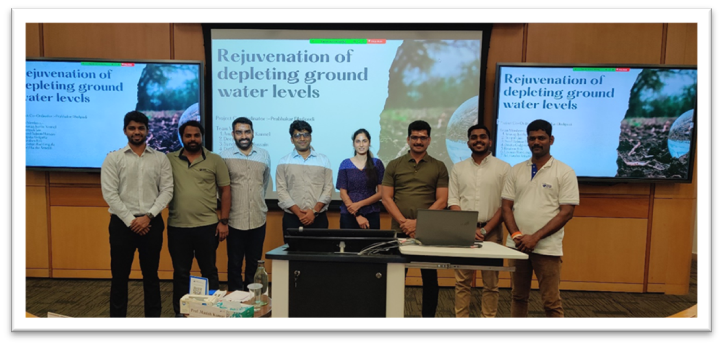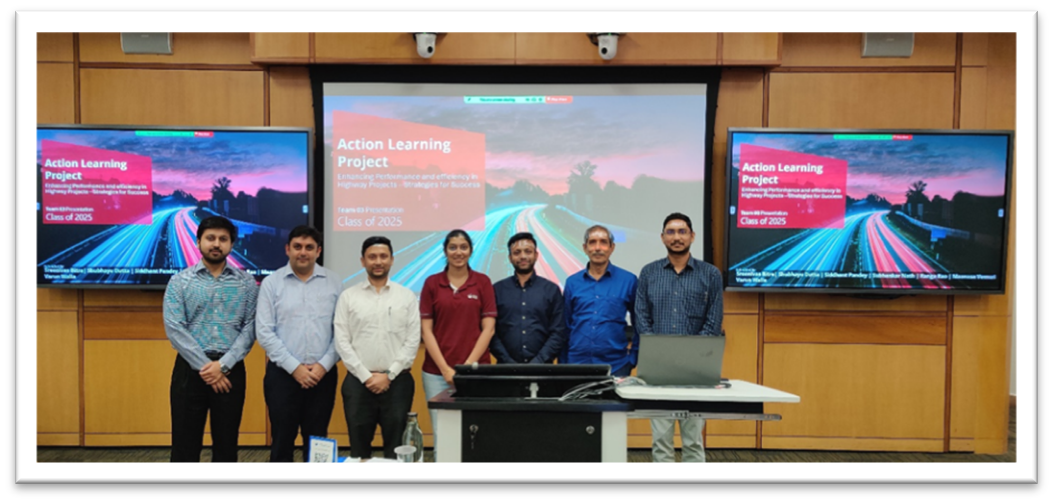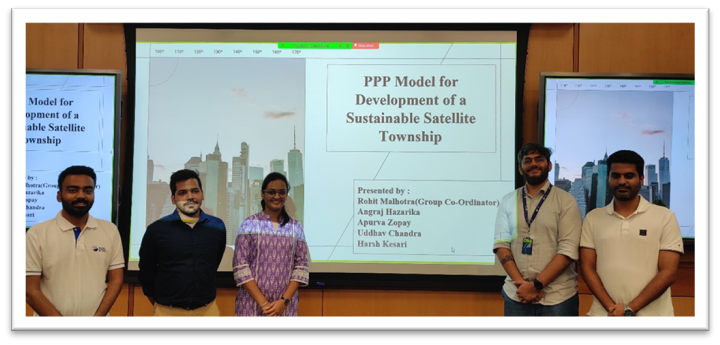
Vol.3, Issue 2, 2024
Infrastructure Quarterly

Professor Chandan Chowdhury, Executive Director, PLIIM
Punj Lloyd Institute of Infrastructure Management (PLIIM) is established within the Indian School of Business as a specialist Institute to support its Infrastructure agenda. The Punj Lloyd Institute of Infrastructure Management seeks to help create top quality management capacity for the Infrastructure and Real Estate Sectors.
Vision
To create high-quality leadership and management capacity for the infrastructure and real estate sectors and create an understanding of the sustainability dimensions impacting the sectors, by delivering quality education, contextual research, and continuous outreach.
Mission
- Create top-quality educational and training programmes
- Facilitate learning through online programmes
- Undertake research that is contextual to the Indian and developing country context
- Develop tools and decision support systems to support the infrastructure practice
- Undertake continuous outreach to support the sector
- Serve as a "Go to" place for the infrastructure sector in India and abroad.

The Punj Lloyd Institute undertakes various initiatives to guide the infrastructure sector toward efficient and sustainable development through research initiatives, knowledge-sharing events, and training public officials and industry professionals. To meet its vision, the institute works closely with corporates in three verticals, Education, Outreach, and Research.
Education
AMPI: Co2025
The eighth offering of the Advanced Management Programme (AMPI) commenced its second residency from 3 August to 11 August 2024 at the Mohali Campus. We currently have 27 students enrolled in our Co2025 Advanced Management Programme for Infrastructure. The cohort has an average experience of 12 years, representing a mix of middle, senior, and top management

Class of Co2025
- The students studied core subjects related to infrastructure during the residency and made presentations of their action learning projects.
Classroom Excellence
Subject: "Prof. Jit Bajpai’s Engaging Course on Sustainable Infrastructure: Inspiring Future Leaders"
Professor Jit Bajpai’s course on Social and Environmental Issues in Infrastructure wasn’t just another class—it was an eye-opening experience into the world of sustainable development. From the start, Prof. Bajpai engaged students with powerful visuals and discussions, making the urgency of sustainability impossible to ignore. The images of our planet in crisis sparked meaningful conversations that felt both relevant and inspiring.
One of the most memorable lessons was Indonesia’s decision to move its capital from Jakarta to Borneo—a bold plan to build a “sustainable forest city” that aims to be carbon neutral by 2045. This case study showed students that sustainability isn’t just a buzzword; it’s shaping real-world decisions and innovations in infrastructure.
What set this course apart was how interactive it was. Prof. Bajpai didn’t just lecture; he created a space where students actively participated. Case studies were a key part of learning, giving students the chance to dive into the challenges of making infrastructure projects sustainable. These weren’t just assignments—they were practical lessons in turning theory into action.
The excitement peaked when students presented their case studies in class. This wasn’t just about showing what they learned—it was a chance to showcase creativity, teamwork, and problem-solving skills. Each presentation brought a new angle to the conversation, making the learning experience richer for everyone.
Professor Bajpai’s course made sustainability feel real and urgent. By the end, students walked away not just with knowledge but with the motivation to lead in sustainable development, ready to make a difference in the world.

Students with Prof. Jit Bajpai
Subject: "Mastering Infrastructure Economics with Prof. Manish Kumar: Empowering Professionals to Shape the Future"
In Prof. Manish Kumar’s course on Infrastructure Economics, mid-career professionals dive into the essential economic principles that shape effective and sustainable infrastructure. This course goes beyond theory, blending practical insights with real-world applications to address both global and local challenges.
- Understanding Economic Foundation: Students explore the economic impacts of various infrastructure types, such as transport, energy, and water systems, with a special focus on both global issues and those specific to India. Analyzing impact through real-world case studies, participants learn how infrastructure influences economic growth, equity, and distribution, making complex theories easier to grasp.
- Financing and Governance: The course covers critical aspects of infrastructure financing, like Public-Private Partnerships (PPPs), and dives deep into the political and governance challenges, preparing students to navigate complex projects.
- Developing Practical Skills: With quizzes, group exercises, and major take-home assignments, the course equips students with hands-on tools for strategic decision-making in infrastructure development.
Prof. Manish’s engaging teaching style and interactive approach ensure that students not only understand the theoretical concepts but also gain the skills needed to make impactful decisions in the field. Known for his supportive mentorship, he creates an environment that fosters both learning and professional growth. This course empowers professionals to lead sustainable and effective infrastructure projects, making a real difference in shaping the future.
Research
Memorandum of understanding between Punjab State Power Corporation Limited and Indian School of Business
This Memorandum of Understanding (MoU), signed on 6 September 2024, establishes a partnership between Punjab State Power Corporation Limited (PSPCL) and the Indian School of Business (ISB). The goal is to collaborate in areas like research, training, and knowledge sharing, with a focus on the power sector.
Key Points:
- Training Programs: ISB will design and conduct specialized programs to enhance the skills of PSPCL employees, utilizing real-world data provided by PSPCL.
- Joint Research: Both parties will work together on research projects related to renewable energy, grid management, and improving efficiency. PSPCL may also fund some of these initiatives.
- Knowledge Exchange: ISB will share its academic expertise, while PSPCL will provide insights and industry trends to enhance ISB's curriculum.
A Decade of Infrastructure Development in India: Trends and Insights
Data analysis from Capital IQ Pro for 1,115 companies in the infrastructure sector is completed and documented to cover the 20 different categories, extending coverage to the water, renewable energy, coal, and gas utilities. Commentaries for more than 100 different graphs have been added to showcase the trends in the last 14 years. The Table of Contents and Summary of the book have been drafted and re-edited to include the latest components from the Capital IQ Pro analysis of secondary data.
The findings from the analyses depict the correlation among various factors like regulatory landscape, industry competition, investment opportunities, and technological innovations that have evolved more in the last decade than in any previous one. Infrastructure is one of the key enablers that will drive the economy in the coming years of Amrit Kaal Vision 2047.
Action Learning Projects
Rejuvenation of depleting groundwater levels using the PPP model
Team Members:
- Prabhakar Dhulipudi
- Anurag Jyothy Kunnel
- Deepak Jain
- Syed Salman Hussain
- Diixita Gulgulia
Synopsis:
This ALP addresses the issue of depleting Water Aquifers by recharging them. The solutions include: (1) To rejuvenate dying lakes and restore RWH (Rainwater harvesting) pits in urban areas. (2) To arrange funds in a hybrid model like “Waste to Wealth" as there is a Lack of capital from the government. The significance of this ALP is immense. According to a study by NITI Aayog, India is facing its ‘worst’ water crisis in history and that demand for potable water will outstrip supply by 2030 if remedial steps are not taken. Nearly 600 million people faced high to extreme water stress. Also, made predictions that 21 cities, including Delhi, Bengaluru, Chennai, and Hyderabad will run out of groundwater by 2030, affecting 100 million people. If matters are to continue, there will be a 6% loss in the country’s Gross Domestic Product (GDP) by 2050. Moreover, critical groundwater resources, which accounted for 40% of India’s water supply, are being depleted at unsustainable rates and up to 70% of India’s water supply is contaminated. Therefore, water resources available to the country should be brought within the category of utilizable resources to the maximum possible extent.

Team 1
Unified Gateway for Clearances in Indian Railway Projects
Team Members:
- Krushang Shah
- Yuvraj Kanade
- Deepti Belday
- Vandit Maheshwari
- Varun Jain
- Sandeep deb
Synopsis:
For contractors working with Indian Railways, an entity that operates across borders and functions, obtaining approvals and clearances for projects often becomes highly bureaucratic. We believe that a re-imagined unified gateway system that connects relevant stakeholders through Digital Public Infrastructure (like E-Office, API Setu, India Stack) will make the entire process much more transparent and efficient and help make projects more efficient by setting up frameworks to identify bottlenecks in the approvals and clearances. The scope includes (1) Approvals and clearances post awarding of tender in Railways, (2) Analyzing completed projects in Railways, and (3) Failures of past single-window vs successful systems.

Team 2
Strategies for enhancing the performance and efficiency of highway projects
Team Members:
- Venkata Ranga Rao
- Subhankar Nath
- Shubhayu Dutta
- Sidhant Pandey
- Manasa Vemuri
- Sai Sreenivas Bitra
- Varun Walia
Synopsis:
For the majority of the ongoing/ awarded road projects, consistent delays are experienced thereby causing exchequer loss to both the owner and the concessionaire. Considerable studies have been dedicated to evaluating reasons with a focus on prebind processes. However, there exists an imminent need for multi-faceted post-bid analysis, which encompasses inferences from the Concept to completion stages and deciphering the gaps and resulting concerns. The objectives of the study will be to identify the concerns and suggest measures for enhanced performance for effective implementation of the awarded projects from a holistic perspective. The scope includes the study and collection of data and analysis of the same for pain points (both explicit and implicit) based on which improved/amended strategies shall be developed for the ongoing road projects for satisfactory and timely completion for pan India projects.

Team 3
Public Private Partnership (PPP) model for development of Sustainable Satellite Cities
Team Members:
- Rohit Malhotra
- Angraj Hazarika
- Apurva Zopay
- Uddhav Chandra
- Harsh Keshari
- Rajavardhan Tondapu
Synopsis:
Rapid urbanization is leading to overcrowded cities, resulting in a lack of access to basic resources such as clean water, electricity, and public transport to the exploding population. This is a problem in most of the developing countries. The government is planning to develop satellite cities around major urban areas to mitigate this issue. As per United Nations-Habitat’s World Cities Report 2022, India’s urban population is projected to be 67,54,56,000 in 2035, growing from 48,30,99,000 in 2020 to 54,27,43,000 in 2025 and 60,73,42,000 in 2030. By 2035, 43.2% of the population in India will be residing in urban areas. The existing infrastructure in the cities will not be able to handle such a population explosion. To resolve this problem of overcrowding in our cities, the governments and private sector shall come together to develop financially viable sustainable satellite cities that are given access to more inclusive, greener, healthier and safer urban infrastructure for our future generations.

Team 4
Punj Lloyd Institute of Infrastructure Management
Indian School of Business, Knowledge City,
Sector 81, Mohali 140306.



